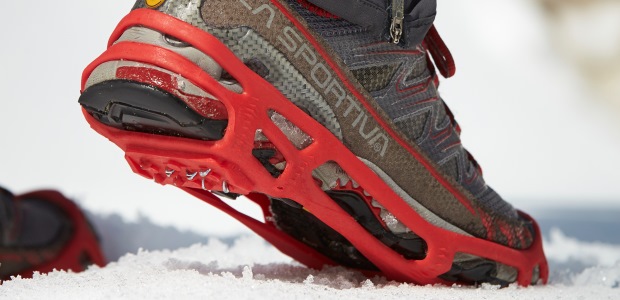
Staying On Your Feet in the Winter
This winter, make ice traction as important as coats, gloves, and hats, because keeping you safely on your feet in snow and ice is as important as staying warm.
- By John Milburn
- Nov 01, 2014
Outdoor winter work can be quite difficult because a variety of challenges present themselves that need to be addressed in order for the day's tasks to be accomplished safely and comfortably. The first priority is basic warmth; there is nothing worse than working outside and being cold. When you are cold, productivity plummets and mistakes tend to increase. The next priority is personal traction on ice and snow, and solving this problem is what this article will address for all of those who work outside in the winter and know the importance of staying on your feet.
Slips and falls are a primary cause of work loss and workers' compensation claims. Most of them happen unnecessarily. The good news is that ice and snow traction is easy and inexpensive and should always be available to those who are out in the elements, whether all day or from time to time. Today, most companies are smart enough to know that providing ice traction devices saves on all fronts. The pain of injury and recovery time, lost work time, and increased workers' comp premiums are all reasons to make sure employees can safely stay on their feet and complete the tasks the job requires without slips and falls.
The Polar Vortex of this past winter found employers as far south as Alabama and Louisiana coping with icing conditions that required ice traction for employees working outdoors. The conditions were particularly difficult because these events were dominated by wet snow and ice with temperatures that would be low enough at night to create icing conditions, which would then melt a bit during the day and then freeze again the next night. These kinds of conditions make for a lot of transition from ice and snow to gravel or pavement, which can then be slippery if you have only metal cleat traction.
Gaining Traction
The key to transitional traction is having both good metal cleat traction and a well-designed rubber or rubber-like compound outsole tread. The best products on the market are those that have both a good metal cleat and a tread that meets or almost meets the cleat, so that when you walk off ice and snow onto pavement or concrete, you are not creating a new slipping condition.
Finding the appropriate traction product really depends on the environment the individual is working in and the traction required to adequately keep that person from slipping. Most slips on ice and snow happen on the heel as we walk forward and the heel of the foot hits ice or snow, causing us to fall backward. All of us have had this experience; sometimes injury can occur even if we recover without falling as we catch ourselves, possibly causing neck and back injuries that are difficult to treat.
We do also slip on the forefoot, but that tends to happen when we are either running or walking up hill. Traction on the forefoot therefore is important and helpful, but it is not as critical as heel traction to stability on our feet. At the end of the day, the best traction is good overall traction coverage, but there are jobs where that is not possible.
In the last few years a new heel-only traction device has been introduced by a number of companies. It is especially welcomed by those who have to drive in the winter for their work. Metal cleats on the forefoot are not recommended due to the obstruction they create when using the gas and brake pedals of the vehicle. Most vehicle surfaces are also metal, so metal on metal can cause slips when getting into and out of a vehicle. Thus, the new heel-only concept allows drivers to leave the cleat on while they are driving, and it gives them that vital heel traction when out of the vehicle.
Choosing the Best Product for Your Needs
So review the type of environment in which your employees work during the winter and determine what type of product works best for you. If they or you are outside for long periods of time, not needing to take off your ice cleats and put them back on regularly, there are some very durable products with full bindings, some of which have replaceable cleats (which is a nice option to help save money when the cleats wear out).
If you are in and out of doors regularly, heel-only products are great, as are those that simply pull over your shoe or boot. They come in the full size range, and some even come in a variety of colors.
This winter, make ice traction as important as coats, gloves, and hats, because keeping you safely on your feet in snow and ice is as important as staying warm.
This article originally appeared in the November 2014 issue of Occupational Health & Safety.